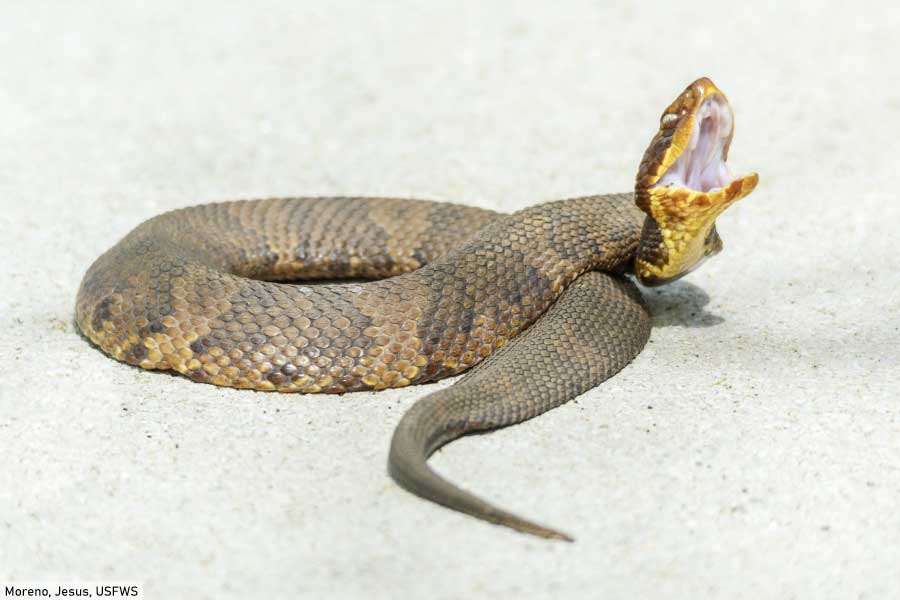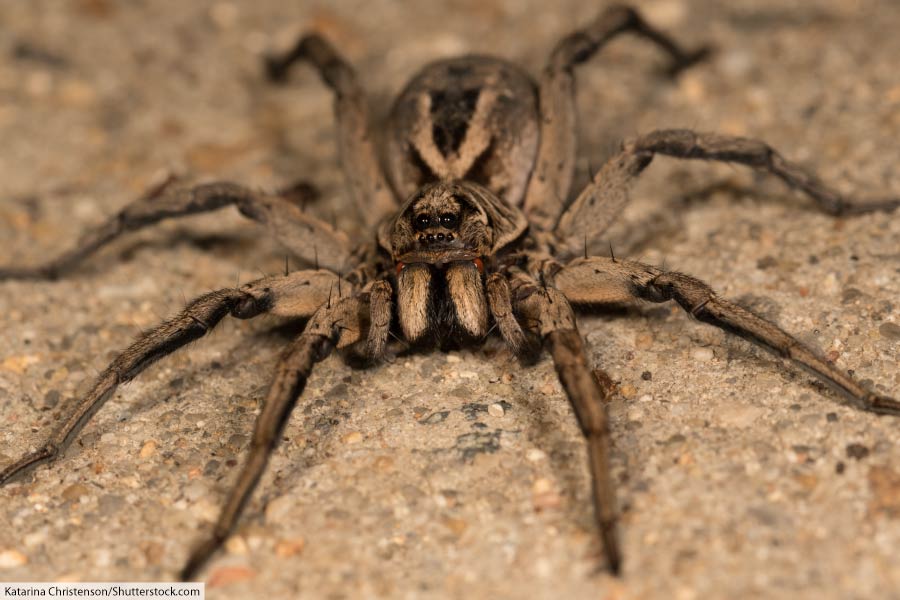A list of ten halloween animals with fascinating facts on each. Scroll down to view the animals, or watch the video below!
What’s your favorite scary animal? Let us know in the comments, and don’t forget to subscribe to our newsletter for more interesting animal facts!
Halloween Animals List
Bats


- Class: Mammal
- Order: Chiroptera
- No. of Species: ~1,435
Bats have been scaring people for centuries due to their nocturnal lifestyles, sinister appearance, and long-standing connections to witchcraft and the supernatural.
Bats are the only mammals that can fly. Their wings are supported by elongated finger bones. These “creatures of the night” find their way around in the dark using sound – an adaptation known as echolocation.
The ears and faces of many bats are specially adapted for hearing and producing the high-pitched sounds used in echolocation. These adaptations give many bats a somewhat grotesque appearance.
Vampire bats, which are found in Central and South America, are widely-known for their behaviour of feeding on the blood of other animals. They were named after the blood-drinking monsters of European folklore.
Camel Spiders


- Class: Arachnid
- Order: Solifugae
- No. of Species: ~1,153
Camel spiders are a group of terrifying-looking arachnids that are mostly found in deserts. Camel spiders are not true spiders, but, like spiders, are arachnids.
Being arachnids, camel spiders have eight legs, along with two additional pairs of appendages on their heads. In camel spiders, these additional appendages take the form of long, leg-like feelers, and freakishly large mouthparts.
Unlike their spider cousins, camel spiders are not venomous. The largest species are around six inches in length, including their legs.
Cockroaches


- Class: Insect
- Order: Blattodea
- No. of Species: ~4,600
Perhaps it’s their large size, their long probing antennae, musty odour, or their association with squalor that make cockroaches one of the most feared insect groups.
There are over four-thousand cockroach species found throughout the world. Of these, only a handful are regarded as pests, infesting human habitats and potentially spreading disease.
The American cockroach is one of the world’s fastest moving insects, capable of running over fifty times its own body length in one second – that’s the equivalent of a human running at over 200 miles per hour!
Perhaps we should give cockroaches some respect: they are highly resilient, able to survive without food for long periods and can even withstand radiation!
Rats


- Class: Mammal
- Order: Rodent
- No. of Species: ~63 (Genus Rattus)
A popular urban myth says that “wherever you are, you’re never more than 6 feet away from a rat”. Although this is not quite accurate, what is true that these adaptable animals have followed humans to nearly every corner of the globe. Rats are found in vast numbers in many cities.
With a global population in the billions, the brown rat is one of the most abundant wild mammals.
Rats are feared because of their association with filth and disease. Rats have historically been blamed for the spread of plagues. The rodents’ resourcefulness, nocturnal behaviour, speed, ability to swim, and sharp teeth add to their sinister reputation.
In some cultures, however, rats symbolize intelligence, and many people keep rats as pets.
Scorpions


- Class: Arachnid
- Order: Scorpiones
- No. of Species: ~2,821
Like camel spiders and spiders, scorpions are arachnids. There are around one-thousand, seven-hundred and fifty scorpion species, most of which are found in desert habitats.
Scorpions are armed by a pair of large pincers and a venomous stinger, which is located at the end of the tail.
One of the world’s most dangerous scorpions is the aptly-named deathstalker scorpion, which inhabits deserts and other dry habitats in North Africa and the Middle East.
North America’s Arizona bark scorpion is another species capable of delivering an extremely painful sting.
Scorpions may have a bad reputation, but even a sting from the most venomous of scorpions is rarely fatal to an adult human with no pre-existing conditions.
Slugs


- Phylum: Mollusk
- Class: Gastropod
- No. of Species: 500 – 600
As mammals, we have very little in common with slugs, which is probably why many people are repulsed by a slug’s slimy skin, tentacles and sticky trail.
Slugs belong to a group of mollusks known as gastropods, which means stomach foot. Also in this group are snails. Although slugs don’t have visible shells like snails, most species have a reduced shell hidden under their skin.
A slug’s slimy skin prevents its body–which is made mainly of water–from drying out.
Most slugs have two pairs of tentacles, both of which are retractable. A slug’s eyes are located at the ends of the top pair of tentacles. The lower tentacles provide a sense of smell.
Snakes


- Class: Reptile
- Order: Squamata
- No. of Species: ~4,000
Snakes are a group of limbless reptiles closely related to lizards. Snakes are predators, and many are equipped with highly-developed adaptations for locating and subduing prey.
Snakes taste the air using their sensitive forked tongues, and species such as rattlesnakes have infrared receptors for sensing the body heat of potential prey.
The most feared snakes are venomous species such as vipers (including rattlesnakes), cobras, mambas and taipans. The bite of certain species in these groups can be fatal.
Scientific studies have found that a fear of snakes, which is known as Ophidiophobia, may be pre-wired in mammals. Being scared of snakes may have been beneficial on an evolutionary level!
Spiders


- Class: Arachnid
- Order: Araneae
- No. of Species: > 48,000
There are over 48,000 known species of spider, and these arachnids are found on every continent except Antarctica. That’s bad news for those who suffer from Arachnophobia, which is an intense fear of spiders and other arachnids.
Like all arachnids, spiders have eight legs. Most are equipped with venomous fangs and organs known as spinnerets that produce silk for making webs and other structures.
Why are spiders so feared? It may be due to their speed, agility and unpredictable movement. In reality, the vast majority of spiders are completely harmless to humans.
Only a few spider species, such as Australia’s Sydney funnel-web spider and redback spider, and South America’s Brazilian wandering spider, are potentially dangerous. Serious injuries resulting from bites from these species are extremely rare.
Toads


- Class: Amphibian
- Order: Anura
- No. of Species: ~580
Toads are amphibians with dry, warty skin and stout bodies. Toads and frogs are closely related and belong to the same branch of amphibians. Toads are more likely than frogs to be found away from water.
Toads are traditionally associated with witches and witchcraft. This association may be due to the fact that many toads secrete poison from glands behind their eyes. These secretions were thought to have magical properties.
Being amphibians, toads metamorphose from aquatic tadpoles to land animals. This transformation, together with their nocturnal habits and warty appearance, further contributes to their scary reputation.
Wolves


- Class: Mammal
- Order: Carnivora
- Scientific name: Canis lupus
The wolf, or “gray wolf” to give it its full name, is the largest member of the dog family. It is found throughout much of the northern hemisphere, and has many subspecies, including the Eurasian wolf and Arctic wolf.
The wolf is an animal of the wilderness, and therefore associated with the unknown. The long, eerie howls produced by a pack of wolves are among the most spine-chilling of all animal sounds.
Early farmers would have lived in fear of wolves attacking their livestock, and it is no surprise that wolves feature heavily in folklore in many parts of the world.
Few, if any, animals have inspired as many myths and legends as the wolf. These range from the legendary werewolf to fairy tales such as “Little Red Riding Hood”.

